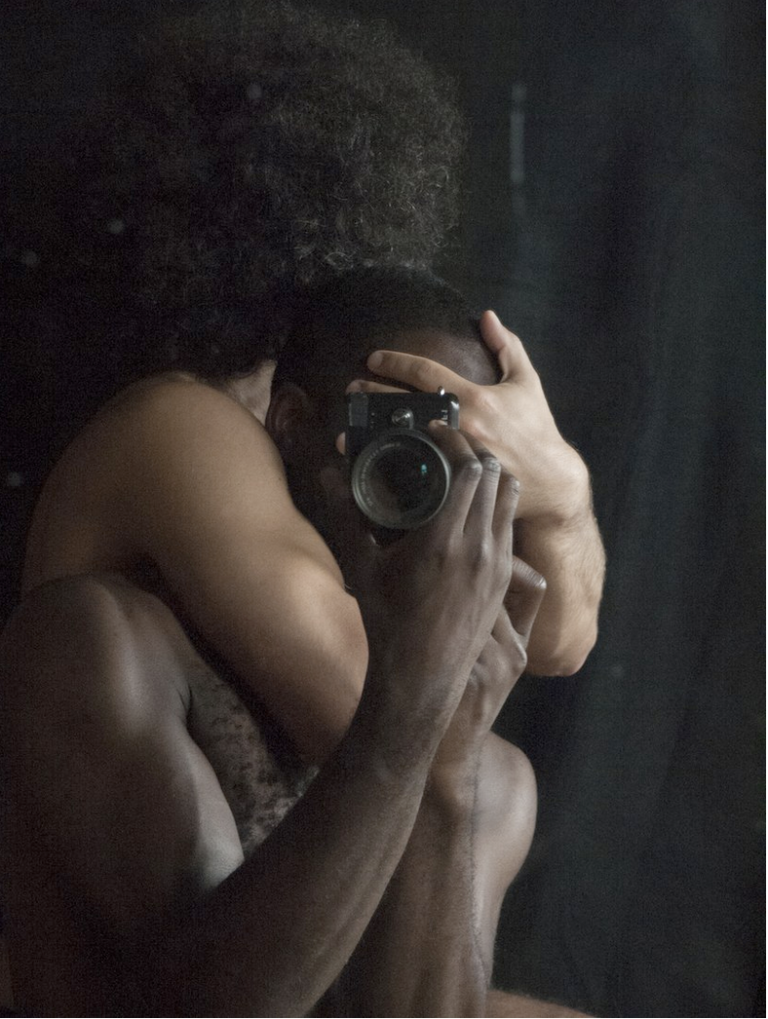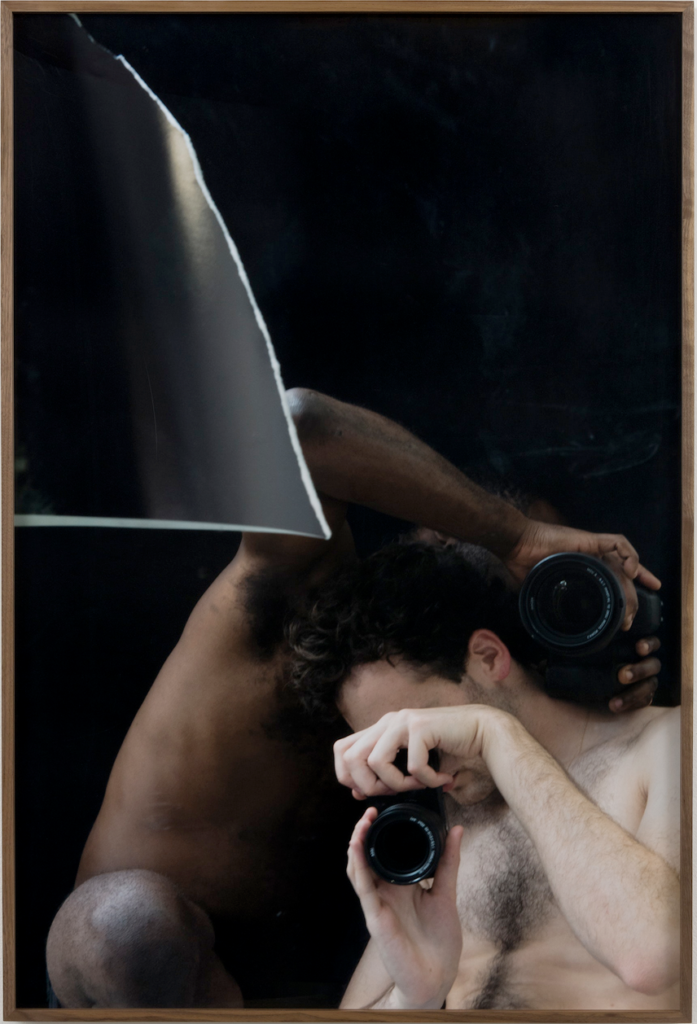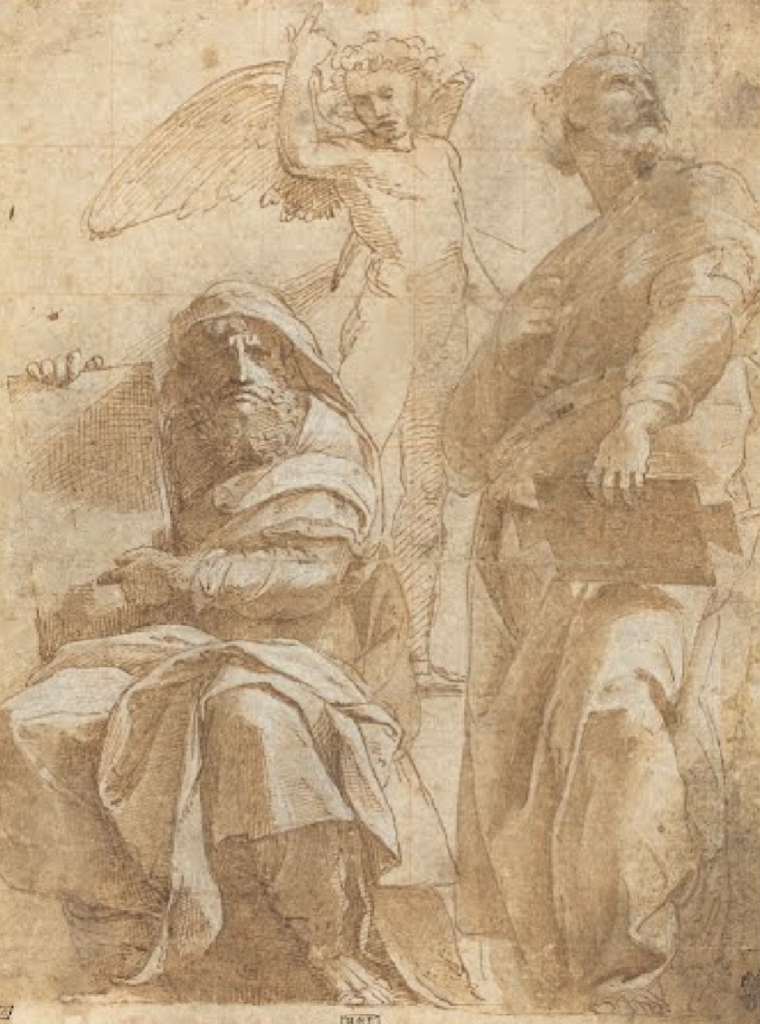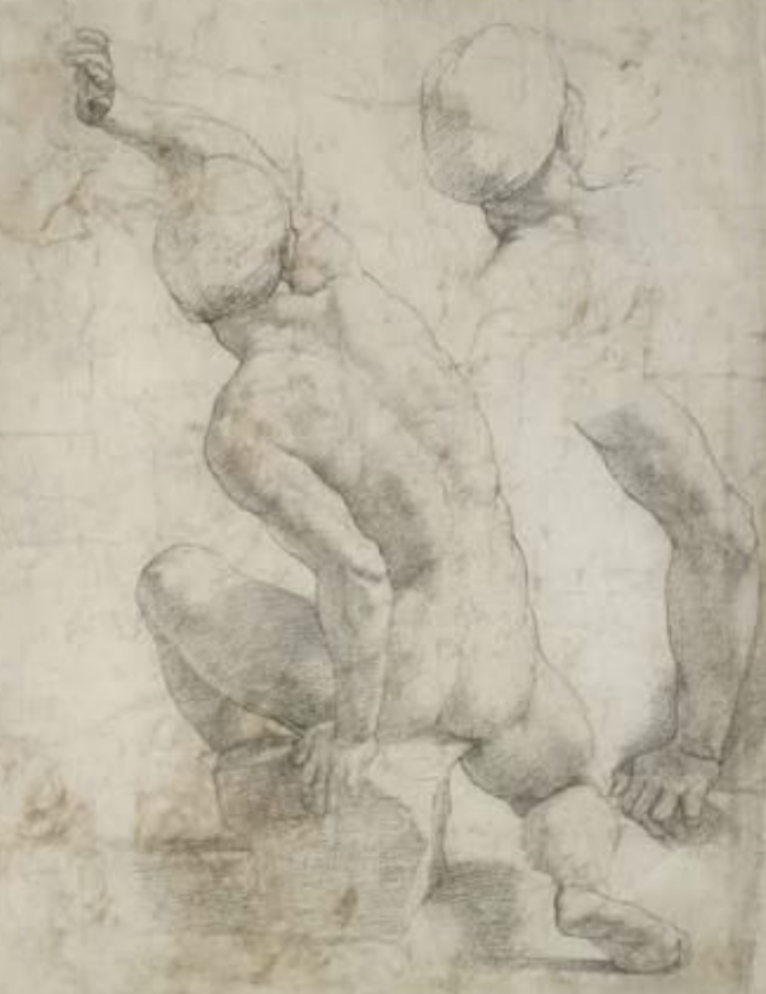In this essay, I will seek to examine the works of contemporary photographer Paul Mpagi Sepuya. I will elaborate on the conceptual and aesthetic components in his photographs, with an attentive review of their careful execution of the ‘metapictorial’ experience. To provide ample insight into Sepuya’s works, I will preface the analysis by first relaying a biographical assessment of Sepuya’s career to date, followed by an overview of the metapictorial concept, drawing on existing theoretical sources. Reflecting on the criteria outlined by such sources, I hope to generate a coherent analysis that concisely identifies the material strategies through which Sepuya stimulates concurrent exertions of self-referentiality, as much in the photograph as in the spectator and the artist himself.
In addition, I will address the significance of time as a defining component in not only the work’s production but also, just as prominently, the resulting content within the photograph itself. Again, this will be facilitated by the mediation and review of existing scholarly materials. The timely component reinforces the work’s status as metapictorial, hence the necessity to acutely examine it within the framework of this essay. In this vein, Sepuya’s sensibilities towards time enact a paradoxical interplay between the artist’s intentions, the logistical processes required to produce the imagery, and his agency in moderating that imagery prior to the spectator encounter with it.
Paul Mpagi Sepuya and his artistic practice
Paul Mpagi Sepuya, born in 1982, is an American artist, based in Los Angeles, known predominantly for his series of studio nude portraits. Sepuya received his art education at the New York University Tisch School of the Arts, acquiring his bachelor of fine art in 2004. Subsequently, he received his master’s at the University of California in 2016. His photographs have been featured in exhibitions on both a national and international scale, including venues in Chicago, New York, Berlin, Paris, and Toronto; further, his photographs are included in the permanent collections of museums such as the Guggenheim Museum (New York, US), Museum of Contemporary Art (Chicago, US) Arish Museum of Modern Art (Dublin, Ireland). [1] Besides an extensive array of museum and gallery exhibitions, his works and interviews have been published in multiple arts and cultural magazines, including Art in America, Flash Art International Magazine, ArtReview and ArtForum. [2] In many of these publications, Sepuya’s photography has been presented as an extension of the existing traditions of studio portraiture, in which he invites the audience into the otherwise private sphere of the artist’s atelier. This space can be understood as the site of production, the place where the object of spectacle is conceived, yet conversely, this site is rarely accessible to art spectators. However, by rendering this space as a defining component in his photographs, Sepuya enables his spectators to witness the creative process.[3] Essentially, the spectator is allowed to exert an almost voyeuristic gaze. Indeed, Sepuya’s models typically pertain to a circle of close friends, lovers, collaborators and other interlocutors in the domains of his professional and personal life. Moreover, Sepuya’s portrait photographs often contain scenographic elements that resonant with the work environment and production process, particularly in the form of details that would be conventionally cropped or hidden from the audience: tripods, holding drapery pegs and wooden constructions etc. ( Fig.1 )

Paul Mpagi Sepuya has described in one of his earlier interviews that his works seek to iterate the relationship between the photographed person, himself as a photographer and the camera. The role of the camera apparatus can be equated to the role of a mediator, enabling the resolution of the complexity of these interwoven threads of relationality between the subject and the artist.[4] In his “Mirror Study” (2016- 2017) series he achieves such a trinity by being present in these photographs and by incorporating mirrors, generating a doubling effect that evokes well-known photographic semiotics concerned with portraiture. As he delineates, for Sepuya the use of mirrors has a long history: in early photography, nude women were often photographed with a mirror so that the viewer could appreciate the beauty of the body from different angles.[5] In his works, the function of the mirror has a much more substantial significance than merely a visual trick to amplify beauty. Beyond this, Sepuya’s inclusion of mirrors serves both a material and conceptual function; they allow one to see multiple sides of his studio, yet further, the reflections break the pictorial space, creating multi-layered collage-like compositions with fragments of the model’s and the artist’s bodies, juxtaposed with the hard fractures imposed by the mirrors. Sepuya’s “Mirror Study” departs from the traditional artist-model dynamic, whereby the latter is typically rendered as an object lacking any agency or mutual relationality between herself and the spectator. Quite the opposite, Sepuya brings to the forefront the choreography of the intimate relationship and employs this tactile, affective sensibility as a strategy of insisting on the subjecthood of those depicted.
As David Velasco has described in his article Project: Paul Mpagi Sepuya, photographic space for Sepuya is a craft of negotiating light in the dark.[6] The article is devoted to the recent project “Darkroom Mirror”, a series of studio photographs of the artist, his models and the camera against a deep dark background made from a mirror reflection. This series, as in Sepuya’s previous project “Mirror Study”, also presents the choreographic interplay between the artist, a model and a camera, yet further enunciated and emphasized by the enclosing, dark drapery. Visually, the dark velvet drapery increases the contrast between the illuminated sides of the body whilst simultaneously softening and dissolving those parts that are sunken beneath shadowy, low lighting. This is observable in Sepuya’s Darkroom Mirror (0X5A9530), ( Fig. 2 ) which portrays two males, the artist himself and a model, holding the camera in front of their faces. The side of Sepuya’s torso that is exposed to the light appears to be even more outspoken, being against the dark background, whereas in the shadows the body gently disappears.

Sepuya’s “craft of negotiating light in the dark” is coherent with an older tradition of studio drawings. Many artists, especially during the Renaissance, worked with the interplay between light and darkness. ( Fig. 3.) The way Sepuya deals with the poses of his models or with his own body in self-portraits, in particular the role of the hands in his compositions, also correspond to the Italian Renaissance canon. For instance, Sepuya’s self-portrait Darkroom Mirror Study (_2110109) (Fig. 4.) and a drawing A seated male nude ( Fig. 5.) by Raphael. Both studio studies depict strong male figures from the back. Although the poses are not identical per se, the compositional choices, the emphasis on the body’s silhouette and the theatricality of the hands are similar.

As aforementioned, it is a recurring motif in many of Sepuya’s works that he depicts himself, whereby it is apparent that he is the photographer, given the presence of his camera. This in turn changes the relationship between the artist, the art object and the viewer. Such dynamics draw upon an extensive tradition and have been associated with the concept of metapicture. In the next chapter, I will delineate the metapicture concept, after which I will pursue an analysis of Sepuya’s photograph “Dark Room (_2070386) in dialogue with the theoretical premise of the metapicture.


The metapictorial Darkroom Study (_2070386)
In order to understand the metapictorial in Sepuya’s Darkroom Study (_2070386), I will initially define the metapictorial criteria by reflecting upon two complementary articles, retrospectively: The meta as an aesthetic category by Bruno Trentini and What is Metapainting? The Self-Aware Image Twenty Years Later by Lorenzo Pericolo. Afterwards, I will introduce Darkroom Study (_2070386). Essentially, by applying these criteria I hope to demonstrate its metapictorial properties.
What is metapicture?
Lorenzo Pericolo, in his article What is Metapainting? The Self-Aware Image Twenty Years Later, defines the metapictorial [8] as: “…the whole gamut of pictorial devices through which painting stages its fictiveness.”[9] He continues by describing the range of strategies through which this premise may be artistically materialised: “Painting achieves this goal by different means: by partially uncovering its materiality; by hinting at, depicting, or putting on view its maker or making; by involving the beholder as an active or even indispensable component of the image; by incorporating a painting—or an image with an equivalent status—as an object of representation.”[10] In other words, a metaphotograph manifests its medium through a mechanism of self-referentially, acknowledging itself as being a photograph; thus, it may depict the artist in the process of its creation or otherwise have the effect of “mise en abyme”, in which the image depicts another image. These elements of the metapictorial, namely, self-referential qualities, along with the presence of the artist and concentric framing inside the frame can all be considered as criteria with which one can identify and demonstrate the metaphotographic properties of Darkroom Study (_2070386).
Bruno Trentini, in his concept of metapicture, also described “mise en abyme” or a frame inside the frame; however, the role and affective response of the viewer in their engagement with work is, for him, central in understanding the conditions of the metapictorial. In his article The meta as an aesthetic category, Trentini states: “In order to realise the strangeness of the picture described as a metapicture, spectators have to distance themselves from their perceptions in order to collect these perceptions from the inside.”[11] Here, Trentini appears to reference the capacity of such imagery to evoke sentiments of disorientation, which in turn provokes the spectator to reevaluate what it is that they have encountered and are perceiving in the work. The spectator’s urge to comprehend the image, coherently and unfettered by this uncanny discomfort, becomes all the more pronounced. Trentini too describes the self-reflective mechanism that is involved in the process of experiencing the metapictorial, though he locates this self-reflectively not only in the production methods of the artist and the content of the resulting artwork, but further he proposes that this exercise of self-awarenesses is provoked in the spectator too, akin to a feedback loop between the artist, the work, and the spectator.[12] Such a mechanism is another important criterion, one that opens up a different perspective with a shift from the properties of a photograph to the cognitive abilities of a viewer.
About Darkroom Study (_2070386)
Darkroom Study (_2070386) ( Fig. 6.) is an image that bears the semblance of a portrait, doubled, whilst simultaneously referencing other photographic motifs beyond those typically associated with portraiture. The image resonates of an anatomical study, a formal composition, and a tonal study. The upper limbs of the one figure rest intertwined with the other one though not discernibly female or male. Both have a dark skin complexion. The face of either figure is not visible to the spectator, with the male figure’s concealed behind the camera that has presumably produced the image by shooting the mirror reflection, meanwhile, his accomplice’s head is turned in the opposite direction.

The metapictorial in Darkroom Study (_2070386)
What makes Darkroom Study (_2070386) metapicture? In order to answer this question, I will apply the criteria as discussed above. As Lorenzo Pericolo stated, the metapicture has self-referential features and manifests its medium precisely through explicating this referral to its own production. In Darkroom Study (_2070386) such criteria appear to be obvious: on the one hand, the photograph refers to a double portrait, and on the other hand, the faces are hidden and cannot be identified, the figures are cropped seemingly for the sake of a stronger visual appeal and artistic framing; thus, the photograph’s value is more aesthetic than documentational.
The photograph has been produced with the help of the mirror. In fact, it’s entire creation is predicated on the presence of a reflective surface towards which the camera lens is confronted with the image of itself. To a certain extent, this mirror could be considered as a transparent frame. That transparency is determined by the relation of the size of the mirror with the size of photographic frame. Such framing references the ideas of Trentini and Pericolo about “mise en abyme”; however the transparency of one of the frames evokes a more complex mechanism or interaction with the image.
On the one hand, Darkroom Study (_2070386) offers a contemplative aesthetic experience in which the spectator’s gaze is kept within the photographic space. On the other hand, the presence of the camera stimulates analytic studies of the image and thus raises questions about the process of its creation. The latter process forces the spectator to take distance and engage in the self-reflective mechanism. Such a mode of interaction is precisely what is described by Trintini as being the experience of metaimage. Thus, it is certainly justifiable to propose that Darkroom Study (_2070386) can be considered a metapicture, given its self-referential features and, in particular, the deployment of the mirror’s surface, which serves as a paradoxical interlocutor, whereby the frame is transparent yet simultaneously loaded with content.
Between the decisive moment and a snapshot in Darkroom Study (_2070386)
Hilde Van Gelder and Helen Westgeest in their chapter “Time in Photography” discuss the so-named ‘decisive moment’ and the ‘snapshot’ as the most commonly mentioned characteristics of time.[13] How can these two characteristics be observed in the metapicture Darkroom Study (_2070386)? In order to answer this question, I shall first provide an account of both of these concepts and, subsequently, analyse the timely characteristics legible in the photograph.
The term “the decisive moment” was coined by a French photographer, Henri Cartier-Bresson, in 1952 when he published the book The Decisive moment, in which he discussed the term and its applicability in reference to his own photographs as material examples.[14] Cartier-Bresson defines the term as: “the simultaneous recognition, in a fraction of a second, of the significance of an event as well as of a precise organization of forms which give that event its proper expression.”[15] For Cartier- Bresson, photography has the power to document the event and present the most essential moment of the narrative. The photographic image in this regard is a representation of the visual world, as moderated by a photographer.
Hilde Van Gelder and Helen Westgeest, writing on the decisive moment, refer to two stages: “one during the photo’s taking and the other during the selection process afterwards.”[16] Paradoxically, these two stages indicate distinct temporalities, with the former being near-instantaneous whereas the latter is a prolonged process of contemplation. Both such temporalities reflect the capacity of the artist to exerts different facets of his agency to construct the narratives abound his surroundings.
Moreover, both temporalities underpin the reflectivity that, as established, is a requirement of the metapictorial. While, on the one hand, the snapshot insists on a rapid evaluation of the photographer’s surroundings — not least, the photographer’s position in that very environment and his capacity to generate an image from that vantage point — the decisive moment, on the other hand, necessitates the exertion of a certain self-criticality. The photographer must consider what it is that he wishes for the spectator to eventually encounter. Ultimately, both temporalities are ensealed in the final artwork.
Van Gelder and Westgeest also mention the main critique of the concept of the decisive moment; namely, its striving to create a perfect image.[17] Nevertheless, such a critic appears rather broad and does not consider the multiplicity of photographic applications, nor the intentions of an artist.
Sepuya, in an interview, mentioned that although his photographs appear to be spontaneous, all elements presented in these images are carefully chosen and staged. The composition of his Darkroom Study (_2070386) also appears to be carefully constructed: the interrelation between the dark background and the human bodies, the distribution of the light and the central position of the camera indicate the decisions undertaken during the creative production process. The presence of the mirror facilitates this process, operating as a haphazard element that inserts an unpredictable influence on the resulting image. Moreover, the dynamism of the models’ poses, the complexity and contortedness of which limit the extensiveness with which they may be held, insert yet another unstable element in this otherwise hyper-moderated set. These aspects, which enable a mechanism of a chance to unfold, may reduce the highly concentrated phase as described by Van Gelder and Westgeest. This makes the decisive moment more instantaneous and changes the purpose of image creating from being a representation of the event to an object of contemplation.
Thierry de Duve in his article Time Exposure and Snapshot: The Photograph as Paradox defines the snapshot as “a theft which steals life.” He continues: “Intended to signify natural movement, it only produces a petrified analogue of it. It shows an unperformed movement that refers to an impossible posture. The paradox is that in reality the movement has indeed been performed, while in the image the posture is frozen.”[18] For De Duve, the snapshot is associated with the indexical nature of the photographic sign, which is incapable of conveying the dynamic nature of reality. Instead, it offers confusing traces of a movement, which clashes with the human experience and ability to perceive the movement. Upon first glance, Darkroom Study (_2070386) portrays a complex movement with unclear purpose, which could be associated with the idea of an impossible posture as described by De Duve. However, despite the seeming lack of functionality, the posture reveals a considered choreography between the subjects and the camera’s lens; the sharpness of the photograph’s focal length, along with the precision of the moderated lighting, further implies that the scenography of the image has been extensively planned – including the interlocking form of the two figures’ bodies. In this sense, the posture serves an aesthetic purpose – here lies its motivation, its function.
To draw to a conclusion, in this paper I hope to have provided ample clarification of the conceptual significance of the metapictorial in the photographic works of Sepuya. In order to demonstrate the productive and aesthetic means through which his photographs can be identified as possessing metapictorial qualities, I have drawn on criteria proposed by Lorenzo Pericolo and Bruno Trentini.
Both Pericolo and Trentini propose an overlapping set of criteria; in particular, notions of self-referentiality are key, though Trentini proposes that the locus of this mechanism needn’t lie solely in the work itself. What I hope to have established by examining the work of Sepuya is that these conditions of the metapictorial can concurrently circulate within the work and amidst the spectator’s experience of it, as well as in the artist’s production of the work.
By reflecting on the temporal interplays that are evoked in the production of Sepuya’s work, whereby the rapid pace of precarity and the prolonged process of carefully choreographing the image are intertwined in a single photograph, it has been my intention to further articulate the underlying reflectiveness of Sepuya’s artistic methodology. Again, it is this very awareness — this acute sensibility towards the conditionality of the work’s production, which is in turn relayed to the spectator by means of the self-acknowledging content of the image itself – that defines the work as metapictorial.
To draw to a conclusion, in this paper I hope to have provided ample clarification of the conceptual significance of the metapictorial in the photographic works of Sepuya. In order to demonstrate the productive and aesthetic means through which his photographs can be identified as possessing metapictorial qualities, I have drawn on criteria proposed by Lorenzo Pericolo and Bruno Trentini.
Both Pericolo and Trentini propose an overlapping set of criteria; in particular, notions of self-referentiality are key, though Trentini proposes that the locus of this mechanism needn’t lie solely in the work itself. What I hope to have established by examining the work of Sepuya is that these conditions of the metapictorial can concurrently circulate within the work and amidst the spectator’s experience of it, as well as in the artist’s production of the work.
By reflecting on the temporal interplays that are evoked in the production of Sepuya’s work, whereby the rapid pace of precarity and the prolonged process of carefully choreographing the image are intertwined in a single photograph, it has been my intention to further articulate the underlying reflectiveness of Sepuya’s artistic methodology. Again, it is this very awareness — this acute sensibility towards the conditionality of the work’s production, which is, in turn, relayed to the spectator by means of the self-acknowledging content of the image itself – that defines the work as metapictorial.
Sources:
[1] Form the website of the artist www.paulsepuya.com
[2] www.documentspace.com/artists/paul-mpagi-sepuya/
[3] www.Hyperallergic.com
[4] An interview with artist Paul Mpagi Sepuya, brought to you by pHytonics.net URL: www.youtube.com/watch?v=asByTnsdScU
[5] Ibid.
[6] Velasco, D., www.artforum.com/print/201903/project-paul-mpagi-sepuya-78670
[7] Bambach, Carmen C. Drawing and Painting in the Italian Renaissance Workshop : Theory and Practice, 1300-1600. Cambridge [etc.]: Cambridge University Press, 1999., p. 27
[8] Scholars, who devoted their studies to the concept of metapicture, namely William John Thomas Mitchell and Bruno Trentini use the term metapicture as a synonym of metapainting. Although there could be some differences, in this essay metapicture, metaimage and metaphotograph will be equally utilized.
[9] Pericolo, L. “What is Metapainting? The Self-Aware Image Twenty Years Later,” in Victor Stoichita, The Self-Aware Image: An Insight into Early Modern Metapainting. 1- 31. London: Harvey Miller, 2015., p.12
[10] Ibid.,p. 13
[11] Trentini, Bruno. “The meta as an aesthetic category”, Journal of Aesthetics and Culture, Vol.6. 2014.,p. 9.
[12] Ibid., p. 11-13
[13] Van Gelder, Westgeest, and Westgeest, Helen. Photography Theory in Historical Perspective : Case Studies from Contemporary Art. Chichester [etc.]: Wiley-Blackwell, 2011.,p.65
[14] Ibid., p. 88
[15] Cartier-Bresson, Henri, The decisive moment (New York: Simon and Schuster in collab. with Éditions Verve de Paris 1952).
[16] Van Gelder, Westgeest, and Westgeest, Helen. Photography Theory in Historical Perspective : Case Studies from Contemporary Art. Chichester [etc.]: Wiley-Blackwell, 2011.,p.65
[17] Ibid., p. 90
[18] De Duve, Thierry. “Time Exposure and Snapshot: The Photograph as Paradox.” October 5 (1978): 113-25.,p.114
Other sources:
Claire Selvin “Susanne Wielmetter Los Angeles Projects now present Paul Sepuya – http://www.artnews.com/2019/01/08/susanne-vielmetter-los-angeles-projects-now-represents-paul-mpagi-sepuya/
Liberty, N. Megan., “Paul Mpagi Sepuya Breathes New Life Into the Genre of Studio Portraiture”,www.artnews.com/2019/01/08/susanne-vielmetter-los-angeles-projects-now-represents-paul-mpagi-sepuya/
Schwabsky, Barry. “Playing with MIRRORS.” The Nation 304, no. 16 (2017): 41-44.